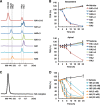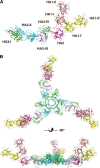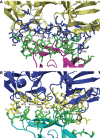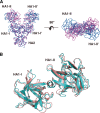Crystal structure of Clostridium botulinum whole hemagglutinin reveals a huge triskelion-shaped molecular complex
- PMID: 24165130
- PMCID: PMC3853306
- DOI: 10.1074/jbc.M113.521179
Crystal structure of Clostridium botulinum whole hemagglutinin reveals a huge triskelion-shaped molecular complex
Abstract
Clostridium botulinum HA is a component of the large botulinum neurotoxin complex and is critical for its oral toxicity. HA plays multiple roles in toxin penetration in the gastrointestinal tract, including protection from the digestive environment, binding to the intestinal mucosal surface, and disruption of the epithelial barrier. At least two properties of HA contribute to these roles: the sugar-binding activity and the barrier-disrupting activity that depends on E-cadherin binding of HA. HA consists of three different proteins, HA1, HA2, and HA3, whose structures have been partially solved and are made up mainly of β-strands. Here, we demonstrate structural and functional reconstitution of whole HA and present the complete structure of HA of serotype B determined by x-ray crystallography at 3.5 Å resolution. This structure reveals whole HA to be a huge triskelion-shaped molecule. Our results suggest that whole HA is functionally and structurally separable into two parts: HA1, involved in recognition of cell-surface carbohydrates, and HA2-HA3, involved in paracellular barrier disruption by E-cadherin binding.
Keywords: Bacterial Pathogenesis; Bacterial Toxins; Botulinum Toxin; Carbohydrate-binding Protein; Crystal Structure; E-cadherin; Epithelial Cell; Hemagglutinin; Protein Complexes.
Figures







References
-
- Poulain B., Popoff M. R., Molgo J. (2008) How do the botulinum neurotoxins block neurotransmitter release: from botulism to the molecular mechanism of action. Botulinum J. 1, 14–87
-
- Sakaguchi G. (1982) Clostridium botulinum toxins. Pharmacol. Ther. 19, 165–194 - PubMed
-
- Oguma K., Inoue K., Fujinaga Y., Yokota K., Watanabe T., Ohyama T., Takeshi K., Inoue K. (1999) Structure and function of Clostridium botulinum progenitor toxin. J. Toxicol. Toxin Rev. 18, 17–34
-
- Hill K. K., Smith T. J. (2013) Genetic diversity within Clostridium botulinum serotypes, botulinum neurotoxin gene clusters and toxin subtypes. Curr. Top. Microbiol. Immunol. 364, 1–20 - PubMed
-
- Schiavo G., Matteoli M., Montecucco C. (2000) Neurotoxins affecting neuroexocytosis. Physiol. Rev. 80, 717–766 - PubMed
Publication types
MeSH terms
Substances
Associated data
- Actions
LinkOut - more resources
Full Text Sources
Other Literature Sources
Research Materials
Miscellaneous

